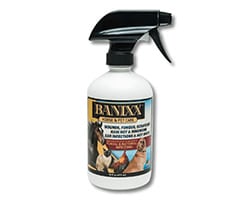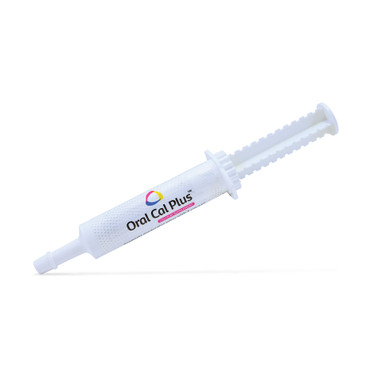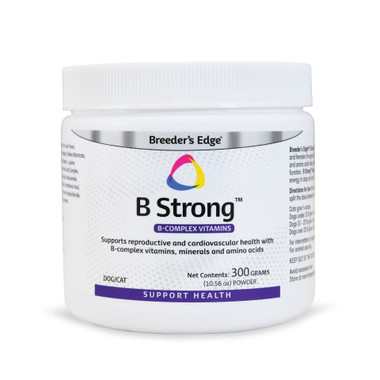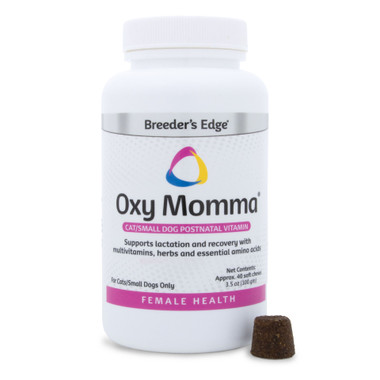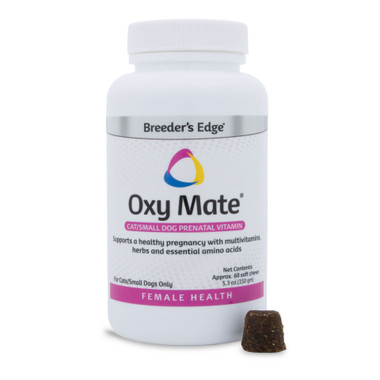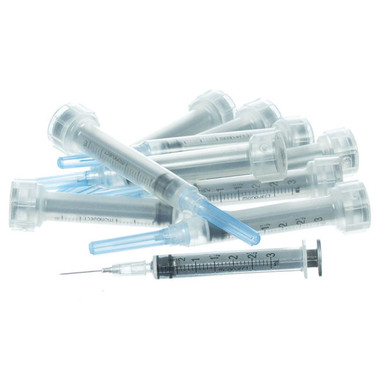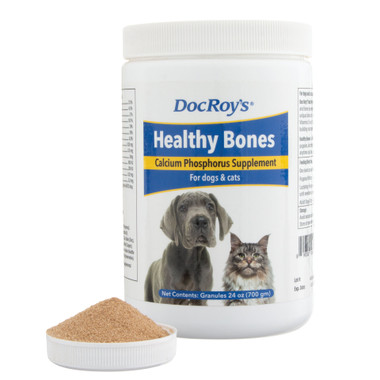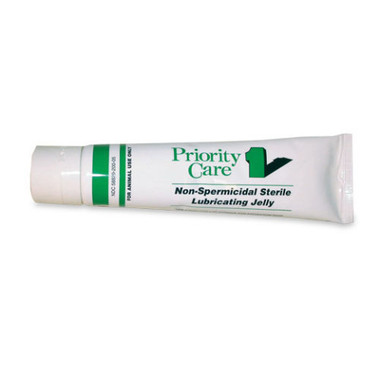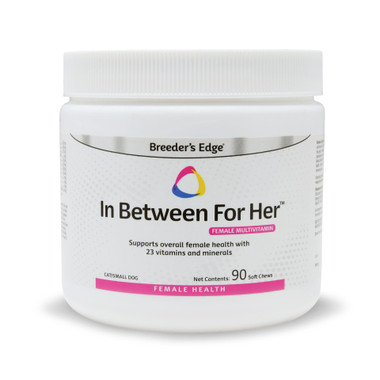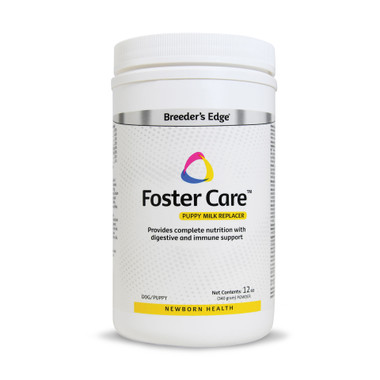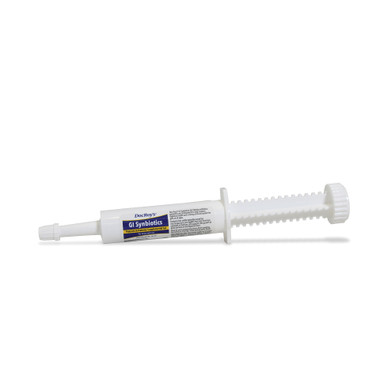EPM...it's not The End like it used to be--successful treatments are underway!
Estimated 0 min read
 Managing EPM
Managing EPM
Caring for a horse with equine protozoal myeloencephalitis can be a challenge, but it’s not always a career-ending diagnosis. In this article, we’ll describe how a Barrel Racer and an Eventer overcame the odds!
Finding out your horse has equine protozoal myeloencephalitis—“EPM” in most circles—can fill a horse owner with dread. But your big dreams don’t have to turn to dust with this diagnosis. Today, with proper care, that includes medication, many horses can go on as successful competitors and useful riding horses. Read on as veterinarian Tony Hicks, D.V.M., owner of Equine Vet Services in Paducah, Kentucky, outlines EPM. He describes how it affects your horse and, most importantly, what treatment is available.
What is EPM in horses?
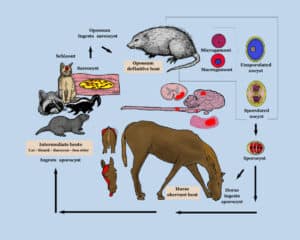
Lifecycle of EPM parasite
EPM is a disease of the brain and spinal cord. EPM is caused by a one-cell parasite calledSarcocystis neurona.Although,horses are considered a “dead-end host” , meaning they don’t share the parasite with others.
Problematic Possums
While the disease can spread in a number of ways, Tony says the proven route is through opossum droppings. Possums are considered the “definitive host” or primary carrier of the parasite that causes EPM.
“A possum can be out in a field, looking for grain and horse manure, they’ll defecate. And then the horse will come along and ingest the disease from those droppings,” Tony said. “Another common way is, possums will sleep in hay barns and defecate on the hay, or on round bales of hay.”
Possums can also get into feed storage containers if they’re not closed tightly. Then they will defecate in the feed container. This results in your horse picking up the parasite through consumption of its feed.
Detecting EPM in Blood
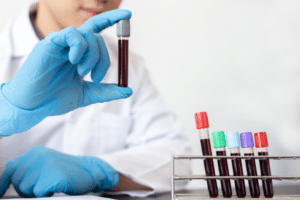
EPM blood test
EPM is diagnosed with a blood test that detects serum antibodies for the parasite. It’s especially common in the Southeastern United States.
“For most horses in the Southeast United States, if you draw blood on them, they’re going to test positive. Further, a serum antibody test will show exposure,” Tony said. “So, most horses have been exposed. It’s when you see it break into the clinical disease that you will see symptoms.
The parasite can reside in a horse’s muscles for years, while the horse’s own immune system keeps the parasite in check. Tony says most clinical EPM cases present when the horse is put in a stressful situation or when its immune system is weak.
“Oftentimes, we’ll have an immunocompromised animal—perhaps a 2- or 3-year-old that is going into training,” he said. “They’re in a stress situation, everything is brand new, their immune system gets compromised. Then, boom, the parasite gets through the blood-brain barrier and into the central nervous system causing the clinical disease.”
The blood-brain barrier in a normal animal works like a screen door. It keeps the majority of pathogens out of the central nervous system, Tony says.
“That’s why, when we get a cold, we don’t get meningitis,” Hicks said. “TheSarcocystis neuronais too large to go through a normal blood barrier. But when the horse gets stressed it can cause inflammation. This will weaken the blood brain barrier so the parasite can get through.
In other cases, issues like arthritic lesions in the cervical vertebrae or a compressed disc causing a traumatic reaction can cause inflammation. Successively, the inflammation process allows the parasite to pass by the blood-brain barrier, Tony says.
EPM Symptoms in Horses
- Muscle wasting over the back and lumbar muscles.
- Rough hair coat that refuses to shed out.
- Loss of muscle in the back
- Asymmetrical muscles on the hindquarters
- Ataxia – lack of coordination
What does EPM look like?

Look at your horse’s muscle symmetry
Clinical signs of EPM in a horse can vary wildly. But often the first significant indications include muscle wasting over the back and in the lumbar muscles.
“One of the telltale muscles where I’ll see atrophy is the temporalis muscle on the right side,” Hicks said. “So right under the forelock on the right side, one muscle will be very tense or developed. On the other side, it’ll look flat and atrophied.”
Other signals include a rough hair coat that refuses to shed out. Also, a deterioration in the lumbar back muscles and asymmetrical muscles on the hindquarters. Ataxia, a lack of coordination or awareness of where the horse’s own limbs are, is another EPM indicator.
Horse Equilibrium
Symptoms of EPM often look dramatic—for example, a horse staggering or unable to get up. But the clues are often subtle. Perhaps your horse used to haul well, but now he panics or refuses to load.
“If you think about it, when the trailer is going down the road, the horse has got to balance itself from side-to-side,” Hicks said. “When the trailer goes around curves, bouncing, and a horse has a neurological deficit from EPM, they’re going to struggle. They won’t want to get in a trailer most of the time.”

If equilibrium is off, it could be a sign
Priscilla Estes has a 2011 sorrel solid gelding named Surprise that she Barrel races. She began putting him on barrels in 2016, when he was 5, but noticed him struggling with the technique. Moreover, the quick footwork tripped him up.
“It was just really complicated for him,” the Lancaster, Texas, resident said. “Especially in his turns.”
In 2018, Surprise’s movement worsened, which worried Priscilla.
“It was so strange—I went into a barrel race, and he was humping up on the backside of the barrels,” she said. “I was trying to work with him on the fence, and he just could not do those maneuvers at all.”
She gave him time off, thinking he was sore, but the gelding failed to improve.
“He literally looked like he was walking with one leg—it was just the most bizarre thing,” Priscilla said. “I thought maybe his pelvis was fractured.”
A lameness exam failed to turn up any issues, but neurological signs—like walking in a “C” shape and struggling to load in the trailer—began to present a few days later. The diagnosis: EPM.
Pinpointing the problem
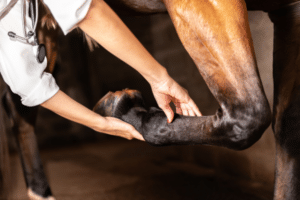
Vet checking for EMP
If a horse is suspected of having EPM, the primary way to evaluate for the disease is a neurological exam. The veterinarian might pull the horse’s front or back leg and hoof out to the side. This will test to see if the horse immediately brings the foot back underneath himself.
“If you put it out to the side and they leave it out there, that’s a pretty good sign that they’ve got a neurological deficit,” Tony said. “We’ll walk him away from us and pull the tail in each direction. If they’re weak on both sides, or one side, that’s a clinical sign as well.”
A veterinarian will also usually draw blood to detect if the horse has had an immune response—antibodies—to the presence of the parasite. But they might also do a spinal tap in one or two locations. The spinal taps are done at the poll with the horse under general anesthesia or at the lumbo-sacral joint of the lower back.
Multiple tests are available to check for antibodies. The original test is a western blot test. But others include an enzyme linked immunosorbent assay (ELISA) test and immunodominant surface antigen designate (SAG1 and SAG2) tests. The SAG2 test is the newest and most specific. Most labs run a combination of these tests because they are each around 90 percent sensitive.
The presence of the parasite does not mean the horse will have EPM, Tony says. You must match clinical signs with the presence of antibodies in the blood and/or spinal fluid.
Managing the disease
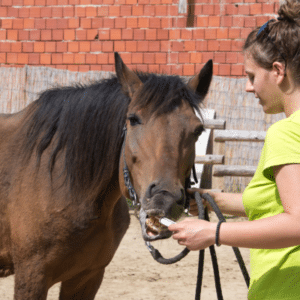
Horse given Vitamin E
Treatment for EPM has evolved, and several medications are available to treat the disease. Most often prescribed are pyrimethamine/sulfadiazine, Toltrazuril/DMSO, Diclazuril or Marquis. However, Tony says a combination of these drugs is sometimes used in more severe cases.
Vitamin E
If a horse is diagnosed with EPM, Tony also often prescribes a Vitamin E supplement, in addition to medications. For more about Vitamin E, readour blogon this topic.
“Once we diagnose them, we keep them on at least 4,000 units of Vitamin E for life to help their immune system. And because the parasite seems to attack what’s called epineurium, which is the covering of the spinal cord. It’s equated to insulation on a wire,” he said. “The parasite damages that insulation and the wire shorts out, damaging the epineurium. The result is that the nerve doesn’t function properly. Vitamin E helps that epineurium regrow and maintain that health.”
Oral Medications
The EPM treatment medications are often given orally and work best when given about 30 minutes before grain. Then again, he says some horses might reject oral medications.
“When there’s a treatment failure, it’s usually because they haven’t managed to take the medication orally,” Hicks said.
If a horse has a chronically compromised immune system or other conditions, such as Cushing’s disease, successful treatment of EPM is somewhat challenging.
“Most of the time at our practice, we see EPM cases in performance horses who are well fed and otherwise healthy,” Tony said. “So, we have a good response rate. But the ones that don’t respond as well may come from other regions. They have moved here so they haven’t ever had the exposure to the disease before.”
Early Detection

Early detection is key
Fortunately, most horses recover from EPM, particularly if the horse is in good shape. A bonus in this is if we get an early diagnosis and prompt treatment. Early detection is the key, Tony says.
“The prognosis is good if it’s detected early,” he explained “But, if you have a 15-year-old horse who has stumbled with you for the last seven years. And then she suddenly gets worse, that horse has probably been battling this disease for a long time. Now it’s breaking through with a true neurological deficit and pretty severe clinical disease. And those horses don’t do as well.”
The more severe the damage is to the horse’s epineurium, the longer it’ll take for the horse to recover. The epineurium grows back at just about two millimeters a month.
Priscilla’s gelding was put on several medications, including DMSO and IV fluids, and he began improving. Subsequently, she started him on Marquis once he returned home, but Surprise began deteriorating again.
“I was afraid we were going to have to put him to sleep because he was getting worse—he was having a hard time swallowing,” she said.
He did ultimately improve, though slowly; his regimen included Marquis, Vitamin E and Eclipse EPM. Today, Surprise still gets Equine Omega Complete, which includes Vitamin E and fatty acid supplementation. Thankfully, he’s made a full recovery.
“He’s back running barrels, and he’s doing really well,” Priscilla said. “Surprise tends to stress; he knows exactly what’s going on in his environment, and little things bother him.”
Is it possible to prevent EPM ? How to prevent EPM?

Create barriers for possums
Eradicating opossums completely is not a realistic strategy, Tony says. And they do offer some environmental benefits, like eating ticks that can carry Lyme disease. He recommends constructing barriers like fencing to keep opossums out of your pasture. Additionally, taking steps to protect your horse’s hay and feed from contamination.
“When we bale our hay and put it up for storage, we are particular to seal it off in a hay loft. We then keep traps around the barn to prevent opossums from getting in. Even with our round bales, we use a baler that net wraps the bales when we store them in a barn,” Tony said.
Even if your horse doesn’t have EPM, Tony says you might consider feeding your horse 2,500–4,000 units of Vitamin E daily as a preventative measure—that’s sometimes helpful for horses in high-stress environments, like competitions. Read more about Vitamin Ehere.
Reducing chances for your horse to encounter the parasite that causes EPM is an important management strategy. But keeping an eye out for clinical symptoms can help you catch a case early. With the right treatment, your horse may return to his previous activity level.
By Abigail Boatwright
Sources
June 2022Paint Horse Journal



